'Huge risk' to some supply chain flows as 3D printing evolves, warns expert

© Haiyin
By Alex Lennane
Carriers and forwarders that ignore the advances of 3D printing do so “at their peril”.In his view of the future of logistics, John-Manners Bell, CEO of Transport Intelligence, warned that 3D printing and robotics would change supply chains – with the flow of time-critical and high value goods particularly affected, and low-value 3D-printed goods having a significant impact on shipping lines.
“My view of the future is the end of globalisation, and return of regional manufacturing. But that will have severe implications for shipping and air freight,” said Mr Manners-Bell.
With 3D printing effectively becoming a new, and instant distribution model, sectors such as aerospace and automotive could be changed significantly. GE, for example, has made big investments in being able to mass produce components for jet engines.
“It could wipe tiers off the spare parts industry, including aerospace and ship spares. It could also affect the automotive logistics sector, which could be a huge risk to some in that sector, and the time critical industry.”
He warned: “There may be other opportunities, but if the mainstay of a business is relying on strikes or other supply chain disruption, 3D printing could be a real threat.”
Mark Millar, author of Global Supply Chain Ecosystems, added: “Technology will disrupt high value supply chains. I’m glad I don’t work for a 3PL any more.
“3-D printing’s time has come.”
And some in logistics are already investing. The port of Rotterdam is establishing a 3-D printing ‘FieldLab’, at which companies can work together on manufacturing projects for the maritime industry – allowing ships to undergo fast repairs after ordering a specific component in advance. The first 3D printer at the port will be commissioned in the second half of this year.
“One Asian port has anticipated that its volumes will be about 20% less in five years,” added Mr Manners-Bell. “They are taking it really seriously. And some other ports are also investing in 3D technology. If they are going to lose transhipment traffic, they need to turn ports into manufacturing centres.
“Ships can become 3D-print hubs too. The market is going to change rapidly. It takes a couple of years to build a ship, so they need to think about this now.”
He added: “Shipping lines will need to take a long hard look at their business model. Some lines say it’s niche, and it won’t have an effect. I don’t think that’s the correct assessment of the threat. They will be affected.
“Those that ignore 3D printing and what it means, do so at their peril. The timeframes are unclear, but there is a lot happening now.”


No comments:
Post a Comment